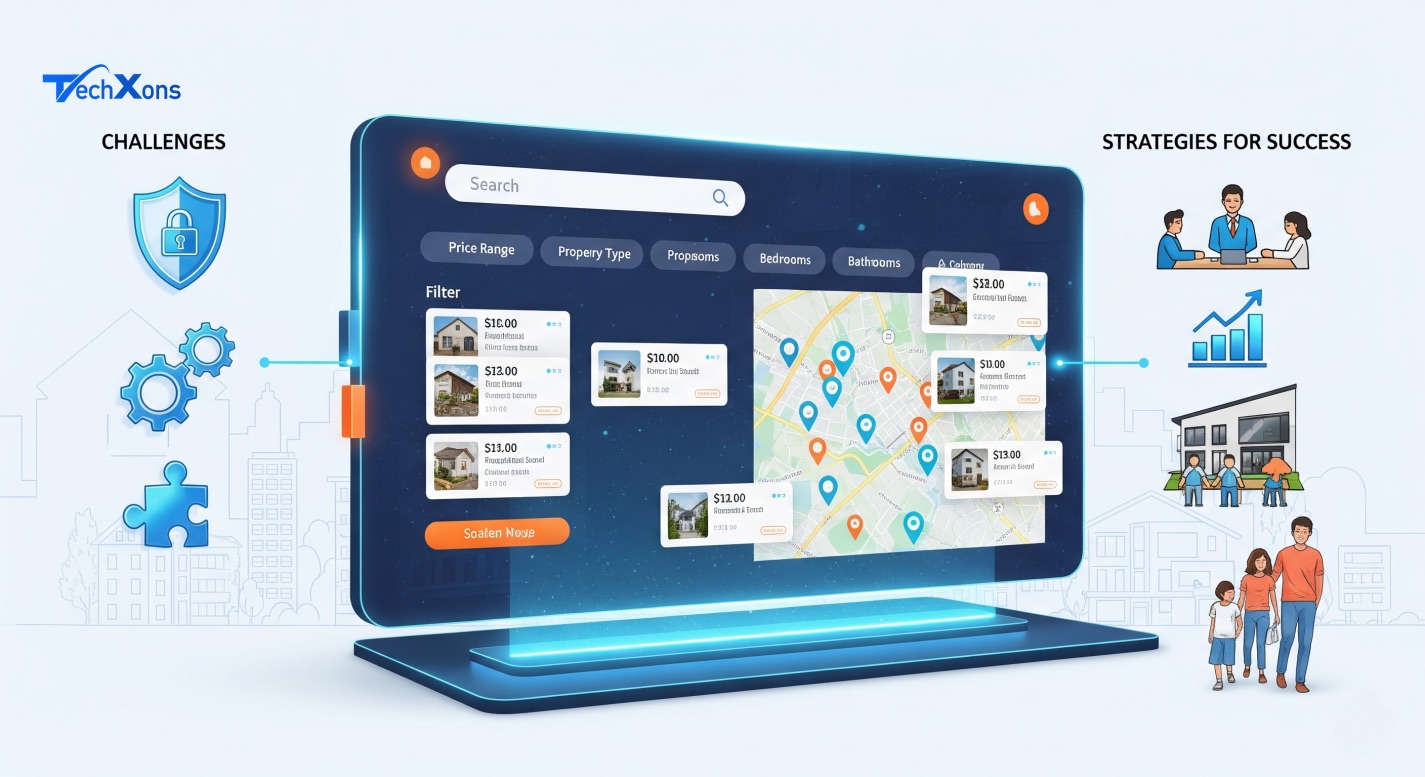
- By TechXons
- 10 Sep, 2025
- IT Consultancy
Building the Next Ride-Sharing Giant: Challenges and Opportunities for an Uber-Like Platform
This article explores the complexities of launching a ride-sharing platform akin to Uber, a leader in urban mobility with operations in over 70 countries. It outlines key challenges, including real-time GPS integration, balancing rider and driver needs, regulatory compliance, scalability, safety, payment systems, marketing, and monetization. Solutions leverage Techxons’ Uber clone scripts, which offer pre-built features like AI-driven pricing, GPS tracking, and customizable branding for quick market entry. The article includes SEO strategies for “Uber clone” visibility, future trends like autonomous vehicles and eco-friendly fleets, and a step-by-step launch guide. Case studies and Techxons’ solutions highlight how startups can overcome obstacles and thrive in the competitive ride-sharing industry.
The ride-sharing industry has transformed urban mobility, with Uber leading the charge as a global powerhouse. Since its inception in 2009, Uber has redefined transportation, connecting millions of riders with drivers through a seamless app. For entrepreneurs and startups, launching an Uber-like platform clone or Say Uber clone promises immense potential, especially as the global ride-sharing market is projected to reach $185 billion by 2026. However, replicating Uber’s success is no easy task, with challenges ranging from technological complexity to regulatory hurdles. For companies like Techxons, which specialize in providing solution clones, an Uber clone offers a fast track to market, embedding advanced features tailored to modern needs.
Uber’s Blueprint: Disrupting Transportation
Founded by Garrett Camp and Travis Kalanick, Uber started as a simple idea to hail rides via an app. Today, it operates in over 70 countries, serving millions daily with services like UberX, UberPool, and Uber Eats. Its success lies in a scalable, technology-driven model that balances supply (drivers) and demand (riders) through real-time algorithms.
An Uber clone replicates this model: a mobile app connecting riders with drivers, featuring fare calculators, GPS tracking, and secure payments. Techxons’ Uber clone scripts provide these functionalities out of the box, with customization options for branding or niche services like airport shuttles or eco-friendly rides. However, building a successful platform requires navigating significant challenges.
Key Challenges in Launching an Uber Clone
1. Real-Time GPS and Mapping Integration
Accurate, real-time navigation is the backbone of any ride-sharing app. Riders expect instant driver matching, while drivers need precise routes.
Why It’s a Challenge:
Solutions:
- Robust APIs: Use Google Maps or OpenStreetMap for real-time tracking. Techxons’ Uber clone includes pre-integrated mapping APIs, reducing setup time.
- Geofencing: Implement geofencing to restrict services to specific regions, optimizing performance.
- Caching: Use local caching to reduce API calls, improving speed and cost-efficiency.
Real-time GPS ensures your Uber clone delivers a smooth user experience, critical for retention.
2. Balancing Driver and Rider Needs
A ride-sharing platform must cater to two primary user groups: riders seeking convenience and drivers seeking fair earnings.
Solutions:
- Dynamic Pricing Algorithms: Use AI to adjust fares based on demand, weather, or events, ensuring driver availability without alienating riders. Techxons’ clones include such algorithms.
- Driver Incentives: Offer bonuses for high-demand areas or consistent availability.
- Rider Promotions: Provide discounts or loyalty programs to retain users.
Balancing these needs builds a sustainable ecosystem, a cornerstone of any Uber clone.
3. Regulatory Compliance and Licensing
Ride-sharing operates in a heavily regulated space, with laws varying by city and country.
Why It’s a Challenge:
Solutions:
- Local Partnerships: Work with legal experts to navigate regional regulations. Techxons’ Uber clone includes compliance frameworks for data privacy.
- Driver Verification: Implement automated checks for licenses, insurance, and background checks.
- Transparent Policies: Clearly communicate terms to users, building trust.
Compliance ensures your Uber clone operates legally and gains public confidence.
4. Scalability and Performance
A successful platform must handle millions of users and transactions without crashing, especially during peak hours.
Why It’s a Challenge:
Solutions:
- Cloud Infrastructure: Use AWS or Azure for scalable hosting. Techxons’ clones are cloud-ready, ensuring performance.
- Load Balancing: Distribute traffic across servers to prevent bottlenecks.
- Database Optimization: Use NoSQL databases like MongoDB for handling large datasets.
Scalability keeps your Uber clone reliable, enhancing user trust and SEO rankings.
5. Building Trust and Safety
Safety is paramount in ride-sharing. Users need assurance that drivers are vetted and rides are secure.
Why It’s a Challenge:
Solutions:
- Background Checks: Use AI-driven verification for drivers, integrated into Techxons’ clones.
- In-App Safety Features: Include SOS buttons, ride tracking, and anonymized contact details.
- User Feedback: Enable ratings and reviews to maintain quality.
Safety features differentiate your Uber clone, fostering trust and loyalty.
6. Payment Gateway Integration
Seamless, secure payments are non-negotiable for riders and drivers.
Why It’s a Challenge:
Solutions:
- Multi-Payment Support: Integrate gateways like Stripe or PayPal. Techxons’ clones scripts support global payment options.
- Automated Payouts: Use APIs to ensure timely driver payments.
- Fraud Detection: Implement AI to flag suspicious transactions.
Robust payments enhance user experience and operational efficiency.
7. Marketing and User Acquisition
Standing out in a crowded market requires aggressive marketing and user acquisition strategies.
Why It’s a Challenge:
Solutions:
- SEO Optimization: Target “Uber clone” and related keywords like “ride-sharing app” in content. This article, for example, is designed for organic reach.
- Referral Programs: Offer discounts for new users or drivers who refer others.
- Social Media Campaigns: Use targeted ads on platforms like Instagram to reach urban audiences.
Techxons’ clones include built-in marketing tools, simplifying user acquisition.
8. Monetization Strategy
Turning your platform into a profitable venture is critical for sustainability.
Why It’s a Challenge:
Solutions:
- Commission Model: Charge a percentage per ride, adjustable via Techxons’ admin panel.
- Subscription Plans: Offer premium features like priority rides for riders or lower commissions for drivers.
- Ads and Partnerships: Monetize through in-app ads or partnerships with local businesses.
A clear monetization strategy ensures long-term viability.
Leveraging Techxons’ Uber Clone for Success
Building an Uber-like platform from scratch can cost $50,000–$150,000 and take months. Techxons’ Uber clone scripts reduce this to weeks, offering:
- Pre-Built Features: GPS, payments, and driver dashboards.
- AI Integration: Dynamic pricing, rider matching, and chatbots.
- Customizability: Tailor for niches like eco-friendly rides or corporate transport.
- SEO Tools: Optimize for “Uber clone” searches.
- Scalability: Cloud-ready for high traffic.
Techxons enables startups to focus on branding and growth, not coding.
SEO Strategies for Organic Reach
To rank for “Uber clone”:
- Keyword Integration: Use “Uber clone” in titles, headers, and meta tags.
- Content Marketing: Publish blogs like “How to Launch an Uber Clone in 2025” for backlinks.
- Local SEO: Target keywords like “ride-sharing near me” for regional traffic.
- Social Media: Share user testimonials on platforms like X to drive engagement.
Email campaigns and influencer partnerships further boost visibility.
Predictions for Uber Clones in 2025 and Beyond
The ride-sharing market is evolving with trends like:
- AI Optimization: Predictive analytics for demand forecasting.
- Electric Vehicles: Prioritize eco-friendly fleets, aligning with sustainability goals.
- Autonomous Driving: By 2030, autonomous vehicles could reduce driver costs.
- Multi-Modal Transport: Integrate bikes, scooters, or public transit.
Techxons’ clones are future-proofed for these innovations.
Case Studies: Lessons from Competitors
- Lyft: Focuses on community-driven branding, offering lessons for niche Uber clones.
- Didi Chuxing: Dominates China with localized features, inspiring regional adaptations.
- Techxons Clients: Several have launched city-specific Uber clones, achieving 10,000+ rides monthly within a year.
Step-by-Step Guide to Launching Your Uber Clone
- Research Market: Identify niches like airport rides or budget transport.
- Select Techxons’ Clone: Choose a script with desired features.
- Integrate APIs: Add mapping, payments, and safety tools.
- Customize Branding: Add logos and unique features.
- Test Thoroughly: Ensure mobile compatibility and performance.
- Launch and Market: Use SEO, referrals, and ads.
- Scale: Analyze data to expand services or regions.
Conclusion: Driving the Future of Ride-Sharing
Launching an Uber-like platform clone is a bold venture with vast potential. By addressing challenges like GPS integration, compliance, and user acquisition, startups can compete in the ride-sharing app space. Techxons’ Uber clone solutions provide a shortcut, embedding AI, scalability, and monetization tools. With strategic marketing and a focus on user trust, your platform can capture the growing demand for modern mobility solutions.




